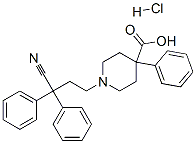1-(3-cyano-3,3-diphenylpropyl)-4-phenylpiperidine-4-carboxylic acid monohydrochloride
- CAS No.
- 35607-36-4
- Chemical Name:
- 1-(3-cyano-3,3-diphenylpropyl)-4-phenylpiperidine-4-carboxylic acid monohydrochloride
- Synonyms
- R-15403;Difenoxin HCl;difenoxin hydrochloride;VMIZTXDGZPTKIK-UHFFFAOYSA-N;Diphenoxylate Impurity A hydrochloride;Difenoxin Hydrochloride (1.0mg/ml in Methanol);1-(3-cyano-3,3-diphenylpropyl)-4-phenylpiperidine-4-carboxylic acid monohydrochloride
- CBNumber:
- CB3902293
- Molecular Formula:
- C28H29ClN2O2
- Molecular Weight:
- 460.99506
- MDL Number:
- MFCD00941510
- MOL File:
- 35607-36-4.mol
| solubility | DMF: 1 mg/ml; DMF:PBS(pH 7.2)(1:1): 0.5 mg/ml; DMSO: 0.1 mg/ml; Methanol: 1 mg/ml |
|---|---|
| form | A crystalline solid |
| FDA UNII | VQZ63K01IW |
SAFETY
Risk and Safety Statements
| Symbol(GHS) |  GHS06 |
|||||||||
|---|---|---|---|---|---|---|---|---|---|---|
| Signal word | Danger | |||||||||
| Hazard statements | H301 | |||||||||
| Precautionary statements | P264-P270-P301+P310-P321-P330-P405-P501 | |||||||||
| RIDADR | 1544 | |||||||||
| HazardClass | 6.1(b) | |||||||||
| PackingGroup | III | |||||||||
| Toxicity | rat,LD50,oral,149mg/kg (149mg/kg),Arzneimittel-Forschung. Drug Research. Vol. 24, Pg. 1633, 1974. | |||||||||
| NFPA 704 |
|
1-(3-cyano-3,3-diphenylpropyl)-4-phenylpiperidine-4-carboxylic acid monohydrochloride Chemical Properties,Uses,Production
Originator
Lyspafena,Cilag Chemie,W. Germany,1980
Uses
The active metabolite of Diphenoxylate. Antiperistaltic; antidiarrheal. This is a controlled substance (opiate).
Definition
ChEBI: The hydrochloride salt of difenoxin. It has similar actions and uses to diphenoxylate hydrochloride, being administered for the symptomatic treatment of acute and chronic diarrhoea. In an attempt to discourage abuse (at high doses, difenoxin acts like morp ine), preparations usually contain subclinical amounts of atropine sulfate.
Manufacturing Process
To a stirred solution of 5.52 parts of t-potassiurn butanolate in 60 parts of dimethylsulfoxide are added 1.7 parts of ethyl-1-(3-cyano-3,3- diphenylpropyl)-4-phenylisonipecotate hydrochloride and the whole is stirred on an oil bath (90°C) for 4 hours. The reaction mixture is cooled (30°C) and poured onto 180 parts of water with stirring. After two extractions with benzene, the aqueous phase is acidified with glacial acetic acid to pH 6.5 with stirring. The precipitated product is filtered off, washed with water, dried, dissolved in 50 parts of 0.4 N potassium hydroxide and precipitated again with glacial acetic acid. The crude free base is filtered off and dissolved in a mixture of 2-propanol and chloroform and gaseous hydrogen chloride is introduced into the solution. The whole is filtered and the filtrate is evaporated. The residue is mixed with benzene and the latter is evaporated again. The residue is recrystallized from 2-propanol, yielding 1-(3-cyano-3,3- diphenylpropyl)-4-phenylisonipecotic acid hydrochloride.
Therapeutic Function
Antiperistaltic





